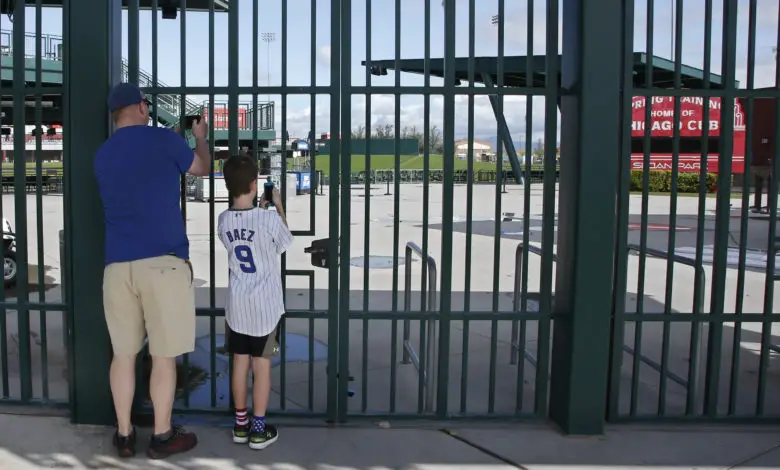
MLB Currently Targeting Early June Start, Playing Max Number of Games with Potential Neutral-Site World Series
They’re playing baseball again in Korea and Japan, which, while both of those countries were well ahead of the US in terms of their responses to the COVID-19 threat, offers a great deal of hope for MLB’s return. There also appears to be pressure from on high to get back to whatever passes for normal these days, though it’s also possible that the curve will indeed have been flattened enough by May to usher in a return to organized activities.
Even without any additional influence on the CDC’s guidance, the current eight-week moratorium on gatherings of 50 or more would take us to May 10. From there, a rebooted spring training could last up to four weeks and have the regular season starting in early June. While everything remains fluid at this point, that reportedly remains MLB’s goal.
“Baseball is looking at a lot of dates, but the target at the moment is in early June,” ESPN’s Jeff Passan told Get Up on Wednesday morning. “The idea is that players would go back around mid-May for a second kind of spring training. Now, that would be an abbreviated one — you know, two, two-and-a-half weeks — and because pitchers wouldn’t be ramped up, they would expand the rosters and go back and play games.
“We don’t know if it would be in front of empty stadiums, we don’t know if fans would be there. They would love, though, to start the season in early June while recognizing that July ultimately may be the likelier and better time to begin the season.”
There are a lot of different directions this whole thing could go, but the downstream ramifications are going to be significant no matter what happens. The biggest driver here is revenue, which is clearly going to take a massive hit from an abbreviated season and will continue to influence decisions by both the league and players union. One such decision being rumored is the potential cancellation of the draft and international free agency as a cost-cutting measure.
That might be right up there with eliminating Christmas bonuses in favor of the Jelly of the Month Club, except it’s actually much worse. Not only would MLB be cutting off its nose to spite its face, since amateur and international free agents represent the league’s best source of cheap labor, but the savings would be minimal. While the roughly $400 million devoted to signing bonuses sounds like a big figure, it breaks down to a little over $13 million per team.
According to fantasy sports expert Craig Mish, one solution reportedly in the works is a truncated draft that might be as few as 10 rounds. That would certainly eliminate a lot of money from the shallow end of the bonus pool, but a huge chunk of that $400 million comes from the top of the draft. This may be more about the lack of scouting stemming from the cancellation of the college baseball season, since the cost savings is insignificant.
News coming at some point from MLB on tentative but still VERY uncertain plans. Sources say both sides would like 140-150 games. Weekly double headers possible. Regular season games in October. June draft will be cut in half at least. Looking at possibly 10 rounds. @SportsGrid
— Craig Mish (@CraigMish) March 25, 2020
Rather than speculate further on the draft, let’s discuss some of the other items Mish mentioned, most notably the idea that “both sides would [STILL] like 140-150 games.” That sounds completely ludicrous when paired with the knowledge that June is the earliest possible start date, even if you factor in the notion of weekly doubleheaders.
Under normal circumstances, a 140-game schedule would be a little more than three weeks shorter than a full season. With Opening Day pushed back by about 10 weeks in the most optimistic scenario, and even factoring in the possibility of weekly doubleheaders, you’re looking at the regular season pushing well into November. No way is that happening.
More likely is a regular season of something like 120 games, which would result in the regular season stretching about three weeks past its initial late-September conclusion. Then you factor in the potential for a playoff structure that could mimic the NCAA tournament and things really start to get squirrelly. Even with a standard format, the postseason would approach December.
“If you have the regular season ending in mid-October, and potentially expanded playoffs beyond that — that’s still being discussed, that’s still being worked out,” Passan explained. “But whether you have expanded playoffs or regular playoffs, they’re going to be going into November.
“When they’re in November, they’re going to need to be somewhere warm. We may be looking at a neutral site World Series in either a dome city or a warm-weather city.”
That’s certainly nothing new and it makes all the sense in the world, but it’s one more thing MLB is going to have to figure out soon. While the NFL and NCAA have obviously done quite well with neutral-site games, they’re not dealing with a seven-game series that would require fans to travel and stay somewhere for much longer than usual. Then again, desperate times call for desperate measures twice before cutting the season once.
Wow, that was a brutally awkward mixed metaphor. Ah, but it’s quite fitting in light of how this whole thing is going to have to be worked out to ensure that MLB can play enough of a season to make the playoffs worthwhile. The real problem is that, as noted above, money is what’s ultimately going to drive the final product.
Fans are going to be so hungry for baseball once it finally returns that it would take a colossal act of buffoonery to mess up the 2020 season and playoffs. But if there’s one thing we should not underestimate when it comes to baseball’s leadership, it’s the uncanny ability to hose their fans by acting in a manner wholly indifferent to what they want.

